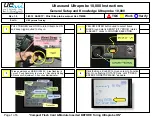
34
About Stop Families
Organ stops are grouped into four main families: Principals, Flutes, Strings and Reeds. Each of
these families is well represented on your Rodgers instrument.
The
Principal
family is the group of stops which are unique to the organ, they aren’t imitative of
other instruments. Principals are often referred to as the “backbone” of the organ and play a
strong role in hymn accompaniments and as the foundation of many chorus registrations.
Examples of stops belonging to the Principal family are
Principal
,
Octave
,
Super Octave
,
Choralbass
and
Prestant
.
In addition, mixture stops, with names such as
Fourniture, Mixture
and
Plein Jeu
, consist of
multiple Principal ranks; the Roman numeral following the name denotes the number of ranks
contained in the mixture. For example, a
Mixture IV
stop contains four ranks of Principal pipes.
The
Flute
family consists of stops which are generally imitative of orchestral flutes and
recorders. This is an extremely diverse group of stops which function in a myriad of ways, from
acting as a solo color to serving as the basis of ensemble registrations, either by themselves or in
combination with other stops. Examples of flute stops are the
Rohrflöte, Flauto Traverso
and
Spitzflöte
.
String
stops do exactly what you would imagine — they imitate the sound of orchestral strings.
These ranks are smaller in scale than most other ranks and usually have a lot of upper harmonics
and a “clean” or “silvery” timbre. This characteristic makes them well suited to accompaniment
and softer ensembles. String stops include the
Viole Celeste II
. Other stops which are a cross
between a String and Flute color are the
Erzähler
and
Gemshorn.
Members of the
Reed
family are also very diverse and are used for everything from solo colors
to the fiery crown in a full organ registration. These stops, also, are often imitative of orchestral
reeds. Examples of reed stops are the
Trompette
,
Hautbois
and
Cromorne
.
Other Families
In addition to the four families of stops listed above, your T787 also has a few other stop families
which can be used.
The
Percussion
family contains voices such as the
Chimes
and
Harpsichord
. These stops have
a percussive attack and gradually grow softer as you hold the note. Rodgers’ advanced
TrueChimes™
system insures that all aspects of the digital chimes voice is exceptionally
realistic. Unlike many other systems, the decay of notes played on the Chimes isn’t affected by
changes in the registration.
Also present in the T787 specification are voices in the
Orchestral
and
Choral
families. Found
as Voice Palette selections, these timbres allow a myriad of opportunities for musical expression.
Examples of Orchestral colors include the
Strings
and
Slow Strings
; Choral voices are
represented by
SATB Oo
and
SATB Ah
textures.
Summary of Contents for Trillium T787
Page 1: ...Rodgers T787 Owner s Manual Copyright Rodgers Instruments LLC...
Page 2: ......
Page 6: ...iv...
Page 12: ...1...
Page 14: ...3...
Page 90: ...79 RODGERS T787 CONSOLE DIMENSIONS...
Page 92: ...81...
Page 96: ...85...
Page 100: ...89 INSTRUMENTS LLC 1300 N E 25th AVENUE HILLSBORO OREGON 97124 503 648 4181 1905 787B...
















































